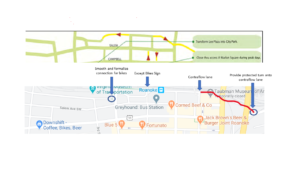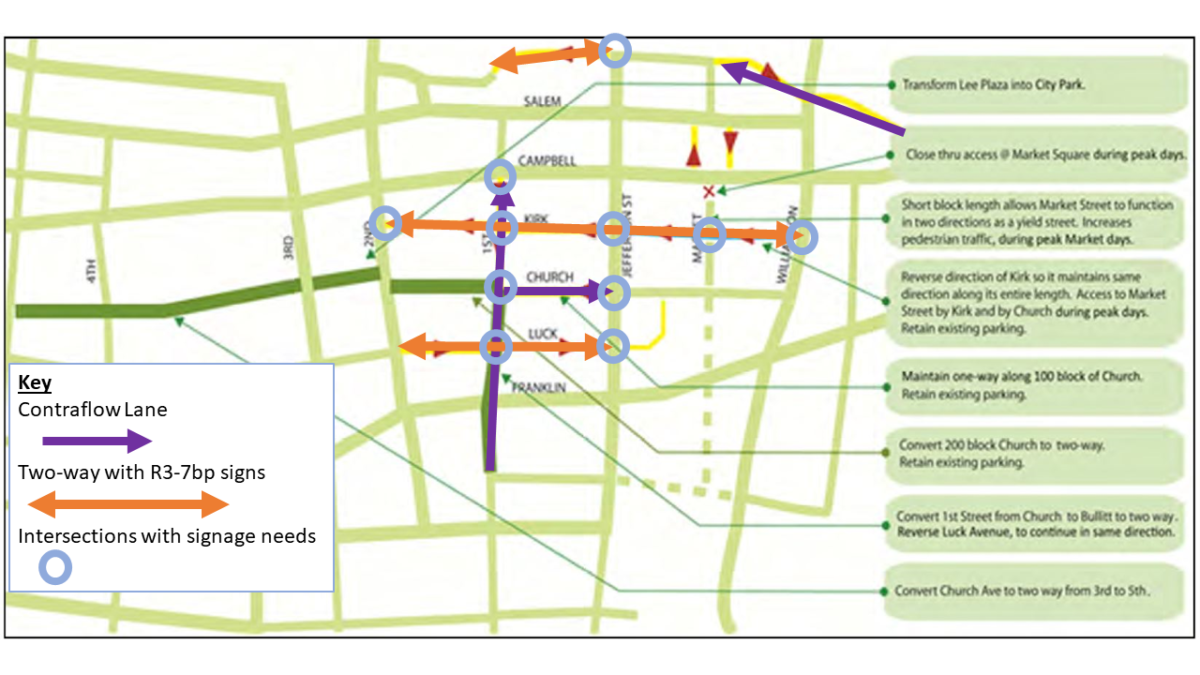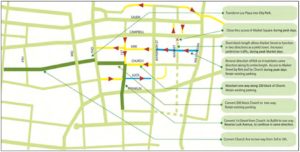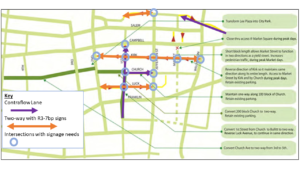Roanoke’s 2017 Downtown Plan identifies the many one-way streets downtown as a barrier to a thriving downtown. The Plan says:
“Restoring two-way traffic is a tried and true revitalization strategy. Salem and Campbell Avenues were both converted back to two-way in the early 2000s, with considerable objection. Since then, downtown has prospered and many now support the changes after initially opposing the idea.
At present, 1st Street, and Church, Luck, and Kirk Avenues are the significant one-way streets in downtown. Conversion to two way streets would greatly benefit: public safety… property values… and overall livability.” (emphasis added)
The plan goes on to suggest some ideas for changes but makes clear that final decisions should be coordinated with adjacent businesses and property owners. In this blog, I’m going to lay out what I would like to see so that the city, adjacent businesses and property owners, and anyone else can understand my experience with bicycling downtown and how it is affected by one-way streets, focusing on the one-way streets identified as significant in 2017.
1st Street
I typically approach 1st Street from Luck Avenue as I ride into downtown. As 1st Street is currently a one-way street heading south, away from downtown, 1st Street acts as a barrier for me and directs me away from my destination. It would be a great improvement to make 1st Street two-way for bicycle traffic.
There is plenty of room for an unprotected contraflow lane on 1st Street. An unprotected contraflow lane would not be ideal, but would be cheap and a huge improvement for cycling circulation. With a contraflow lane on 1st Street bicyclists should be directed to follow pedestrian signals, which exist at every signalized intersection on 1st Street. A contraflow lane would make the most sense on the East side of the Street from Bullitt Ave SW to Campbell Ave, where 1st Street becomes two-way for one block before dead ending in the MLK Bridge. It is possible that parking could be shifted to protect the contraflow lane, and if there is a space for that on 1st Street or any other street downtown then it should be done if possible.
Along 1st Street, it would be best to have bicycle signals for the contraflow lane. But, to save money, the city should consider using R9-5 signs that direct people biking to use pedestrian signals. This would save a significant amount of money associated with a contraflow lane and would allow the city to move forward with a more provisional design while larger changes to downtown circulation are discussed. All of the signalized intersections on 1st Street through downtown: 1st and Salem Ave, 1st and Campbell, and 1st and Church, have pedestrian signals that could be supplemented by R9-5 signs in order to provide direction to bicyclists using a contraflow lane.

Church Avenue
My big issue with Church Ave is that it has Breadcraft on it, and I really like Breadcraft. Since Church Ave is one-way, I always have to go past Breadcraft and then circle back around to it. In the 2017 Downtown Plan, the suggested changes don’t include making the block with Breadcraft two-way. That block of Church Ave between 1st Street and Jefferson Street is narrow and hard to make two-way for cars without removing parking from one side. However, there should be room for an unprotected contraflow lane on the South side of the street. That would allow easy access to Breadcraft from 1st Street. As with 1st Street, bicyclists should be directed to follow the pedestrian signal at Jefferson Street.
While a contraflow lane or two-way traffic from 5th Street to 1st Street could be nice, it’s not a likely cycling route for me. Making those blocks two-way is in the 2017 plan and would be an okay improvement for biking if that change included bike lanes.
Luck Avenue
Luck Avenue is probably my primary access road to and from downtown. When I head toward downtown, I have to choose between breaking the law by continuing straight along Luck Avenue or detouring to a poorly maintained alley or Franklin Road. When I head away from downtown, I have to choose between continuing straight on Luck Avenue or detouring to Franklin Road. Franklin Road, in either case, involves an uphill climb and often waiting at a signal in order to turn onto a higher traffic road with no bike lanes.
Making Luck Avenue better for biking can be easy. All it takes is the use of r3-7bp signs that say “Except Bicycles” so that the one-way restriction on Luck Avenue does not apply to people biking. It would take three signs, two on either side of 1st Street and one on the west side of Jefferson Street.
Kirk Avenue
Kirk Avenue is pretty amazing to ride on. It’s well designed, it’s low traffic, it has a great downtown vibe. The problem is that it only allows bicycle traffic one-way. Worse, it’s not consistently one-way. The 2017 Plan suggests making it one-way consistently with all traffic going west.
Kirk Avenue is low traffic, so it could be made two-way for bicycle traffic with r3-7bp “Except Bicycles” signs. By my count, it would take four of them to go from 2nd Street to Market Street, and five to go to Williamson Road.
Kirk Avenue is also likely wide enough for an unprotected contraflow lane on the South side of the road. The intersections on Kirk Avenue are not signalized so there would need to be stop signs added at each intersection.
Bonus one-way street: Norfolk Avenue
In the 2017 Plan, Norfolk Avenue didn’t get identified as a significant one-way street and no suggests changes were included for Norfolk Avenue.
In my experience, Norfolk Avenue is very low traffic and an amazing bypass route of downtown when I am biking. It is fun to head past the Virginia Museum of Transportation, bike between the concrete bollards, head along the train tracks along the Railside Linear Walk, and past the Taubman Museum. It is a relief to end the sprint west along Campbell Ave where there are no bike lanes by turning off on Norfolk and cautiously proceeding against traffic, when there is traffic.
With the right changes, Norfolk Ave could be a great place to bike. It could be a recreational diversion for people. It could be a bypass for people who need to bike around downtown. It could be the most separated, low-traffic, and comfortable route for people going to and from downtown. With the transit station moving to the West End in from the of Virginia Museum of Transportation, this route would provide a signal-free, mostly intersection-free, route for scooters and bikes between downtown and the transit center.

The necessary changes are not that expensive or complicated, from West to East they are:
- Putting a R3-7bp “Except Bicycles” sign at Jefferson Street for bicycle traffic coming from the East
- Striping a contraflow lane on the north side of Norfolk Ave from Market Street to Campbell Ave
Some nice features would be:
- Repaving the area by the concrete bollards, and providing signage that this is a bike route
- Striping bike lanes, sharrows, advisory bike lanes or some other bike facility from 5th Street to the concrete bollards
- A convex mirror at the west end of the Railside Linear Walk
- A median island at the intersection of Norfolk Avenue and Campbell Avenue to provide protection to bicyclists entering the contraflow lane and make cars turning left onto Campbell Avenue approach the intersection more perpendicularly


